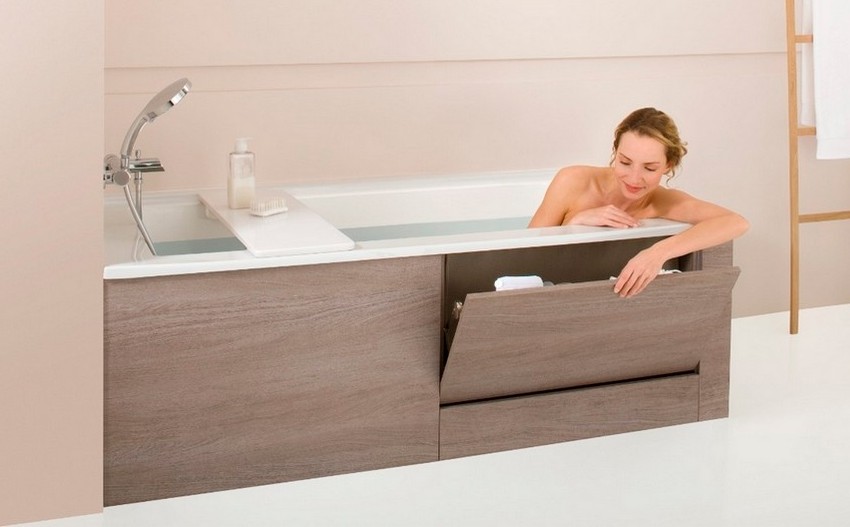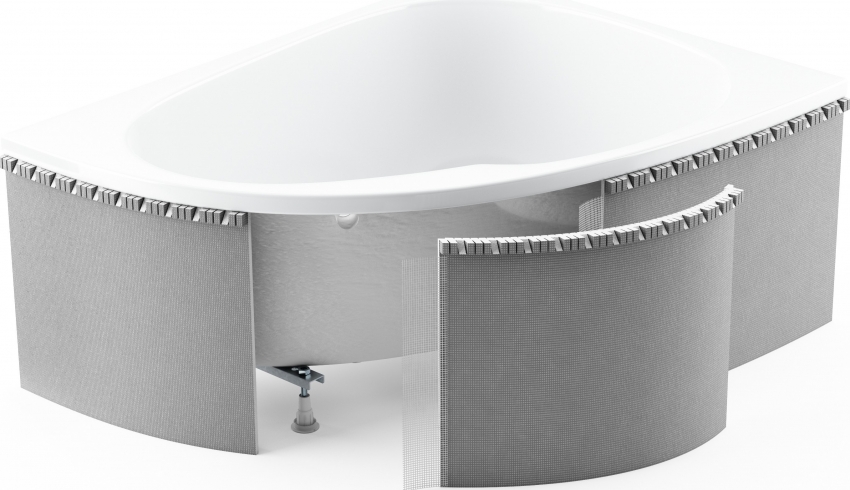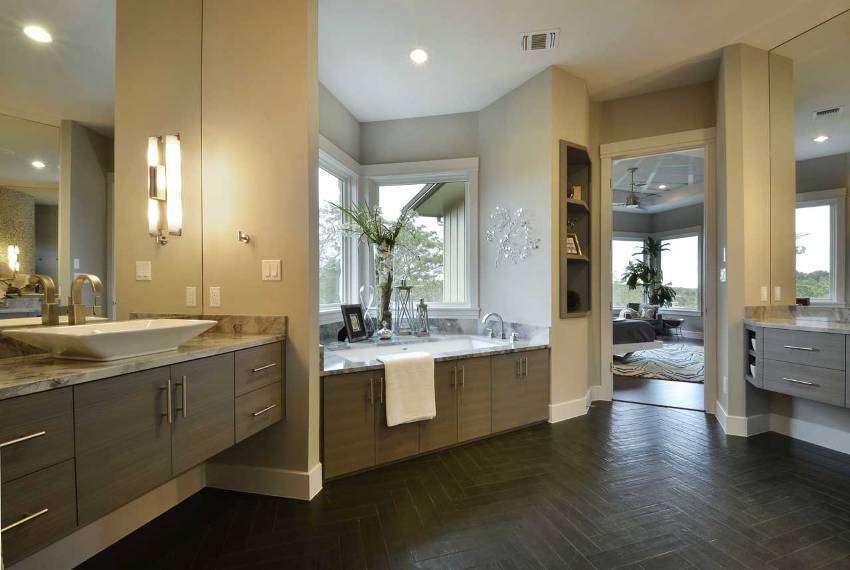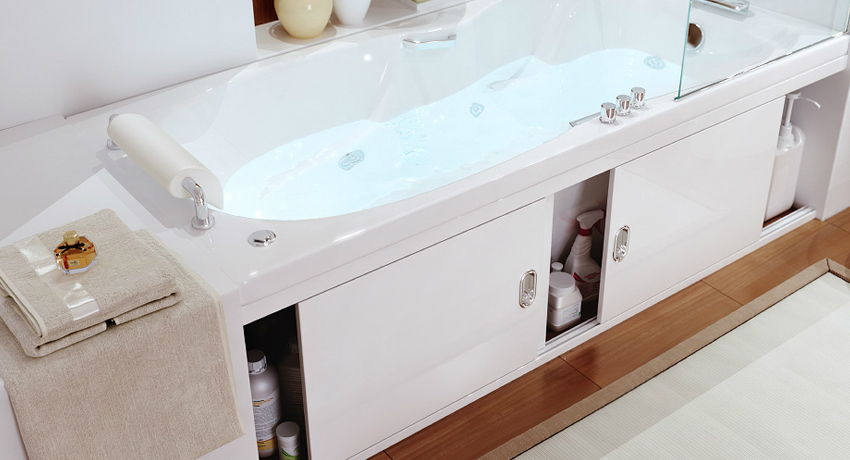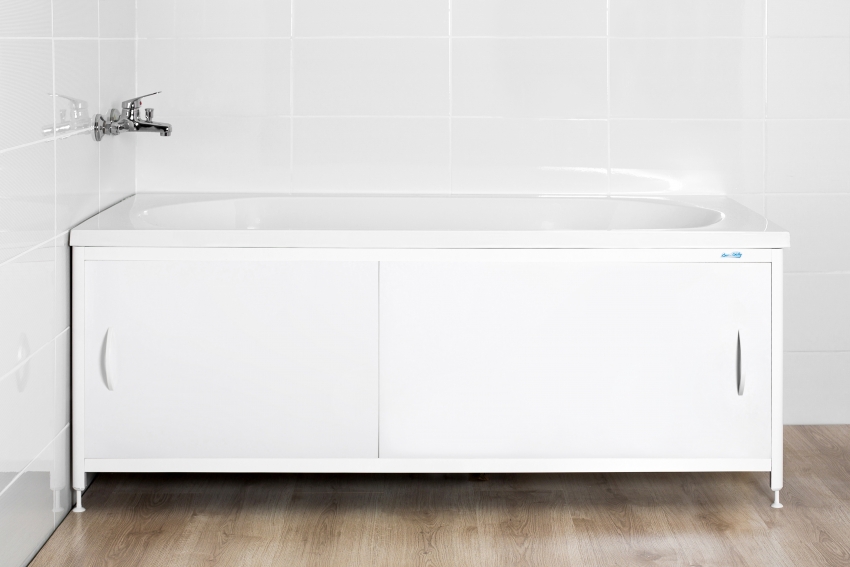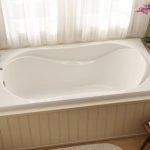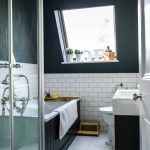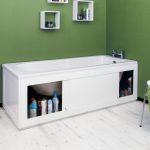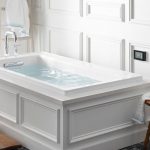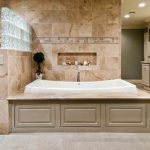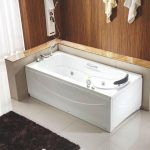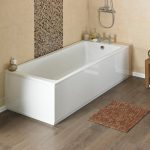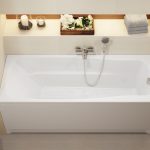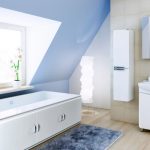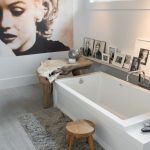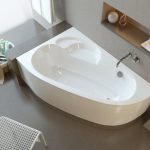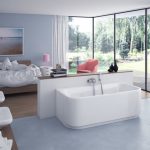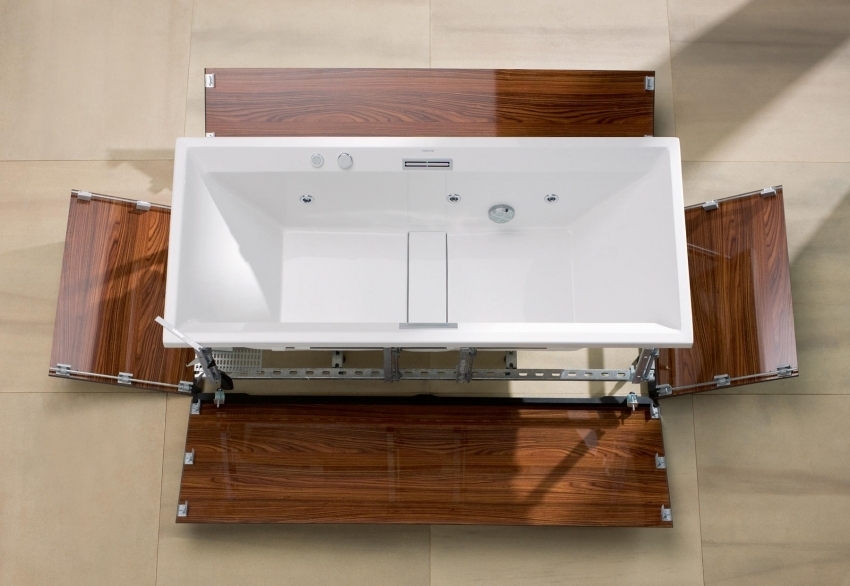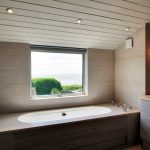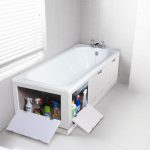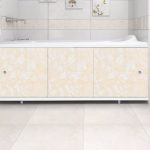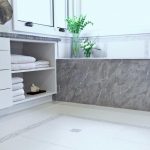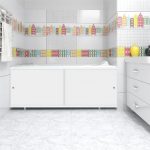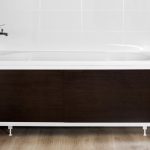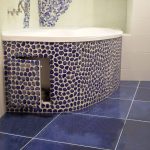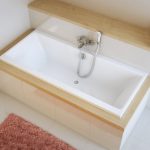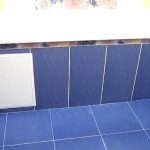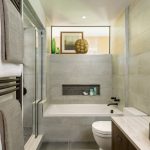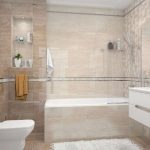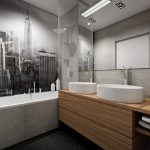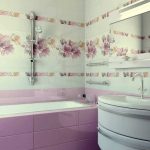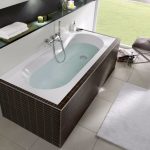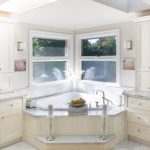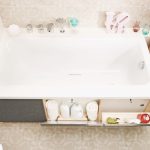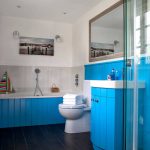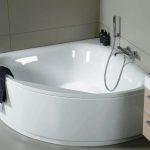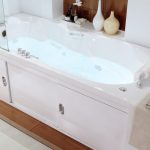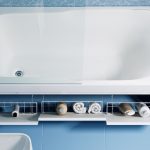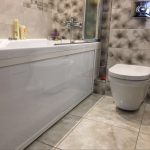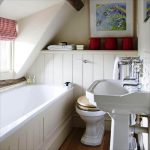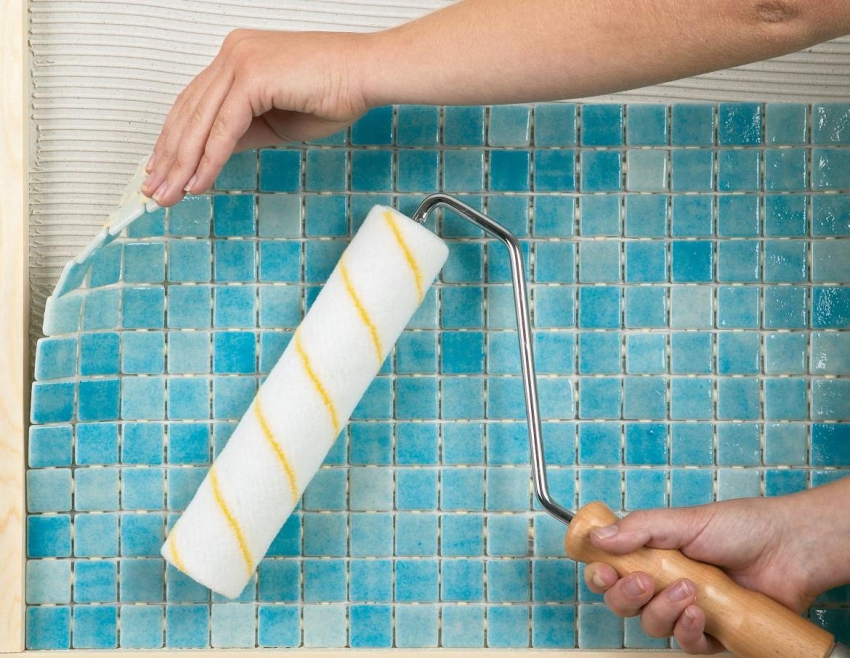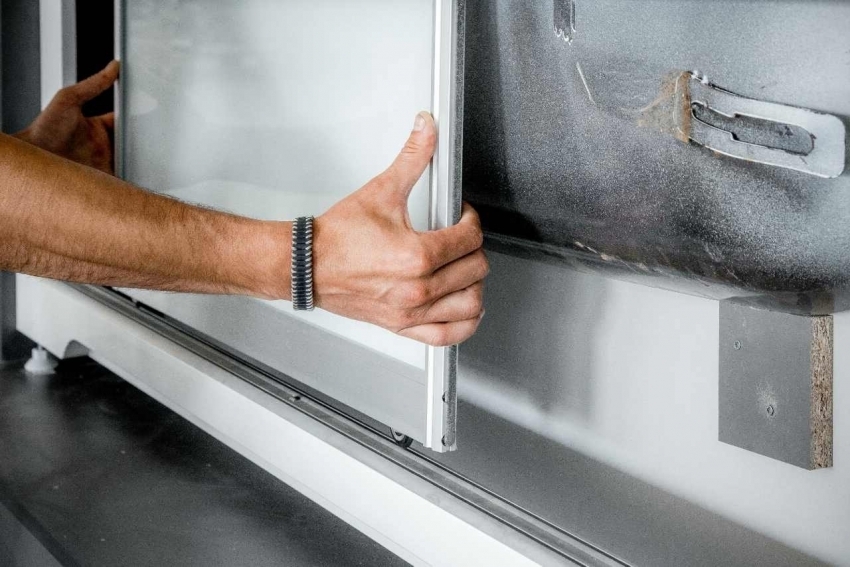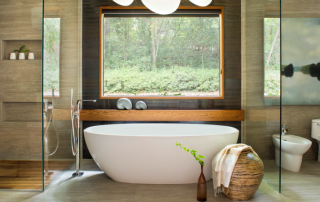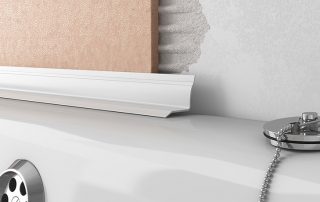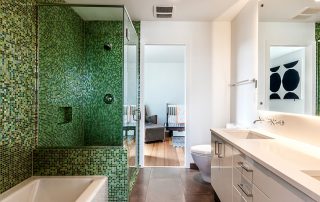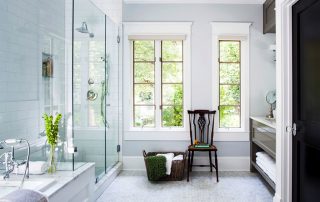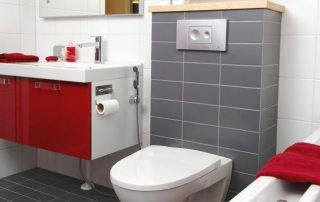A bath screen is a structure that is made of various materials and is used to hide communications. From a constructive point of view, there are several options for such protective panels, which allows you to choose the most suitable product for a particular interior. Screens allow not only to protect pipes from moisture penetration, but also to decorate the room, make it more functional and original.
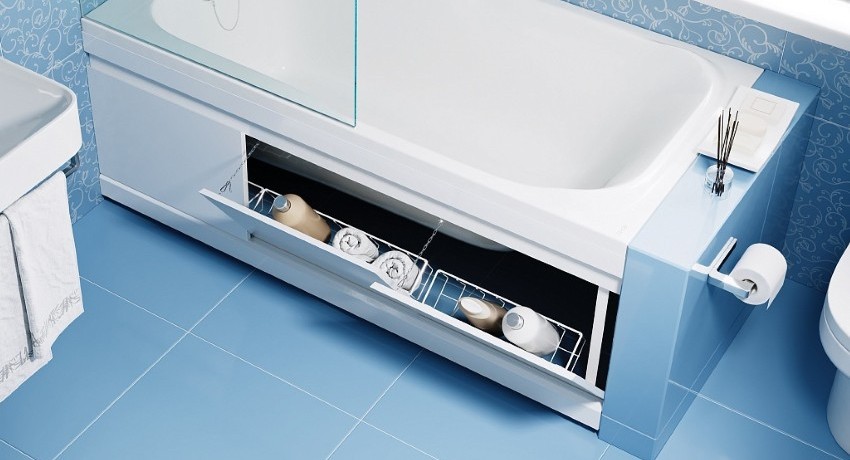
Bath screens are used not only to create interesting interiors in the bathroom, but also to hide unsightly engineering communications
Content [Hide]
- 1 Varieties of panels for baths
- 2 Bath screens dimensions
- 3 Screen design differences
- 4 Features of plastic models
- 5 Acrylic Bath Screens
- 6 Screens from MDF sheets and mirrors
- 7 Plasterboard bath screen
- 8 Ceramic screens for bathrooms
- 9 Screen Selection Tips
- 10 How to make a do-it-yourself bath screen from drywall and tiles
- 11 Mounting a plastic or acrylic screen on a bath
- 12 Video of installing the screen on an acrylic bath
Varieties of panels for baths
Today, bath screens are classified into two main groups:
• solid;
sliding.
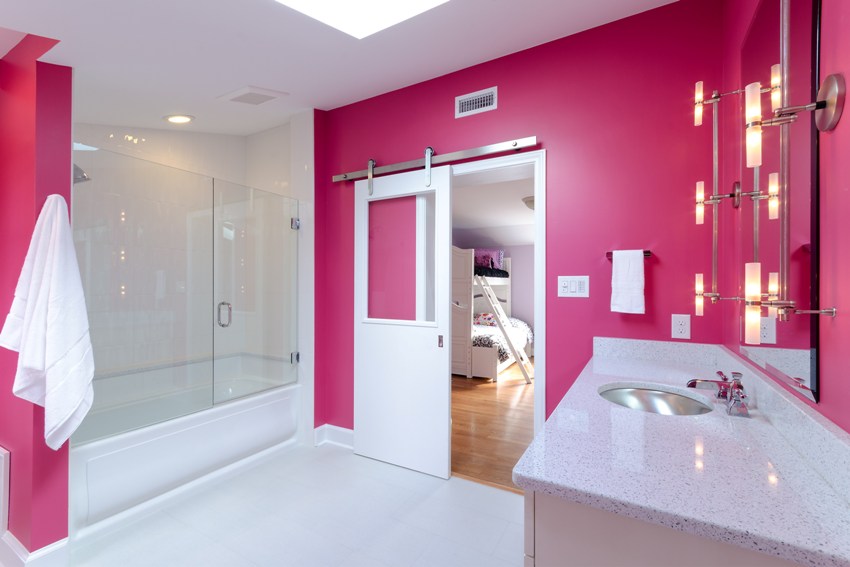
Fixed models of bath screens belong to stationary structures and after installation do not change their position
Solid patterns are the most common and simple. However, the simplicity of the design does not affect its effectiveness. The cladding of such a product, as a rule, is made with the same materials as the rest of the room (for example, tiles). Thanks to this, the panel fits seamlessly into the interior of the bathroom.
Sliding models, in turn, are more functional. The design of such screens allows you to organize shelves under the bathroom for storing household chemicals and other household items. You can buy a sliding-type bath screen in any building hypermarket or profile store. And also it is not difficult to choose and order the product you like via the Internet.
Advantages and Disadvantages of Solid Models
Arranging a solid screen in the bathroom allows you to achieve harmony in the interior of the room. The cladding for such a screen can be very different, but most often they use decorative tiles or mosaics. Products faced with mosaics look the most aesthetically pleasing. Let's consider the advantages of solid models in more detail:
- this design has a long service life;
- solid tiled bath screens are easy to clean. To clean the dirt, just use a damp cloth or sponge.
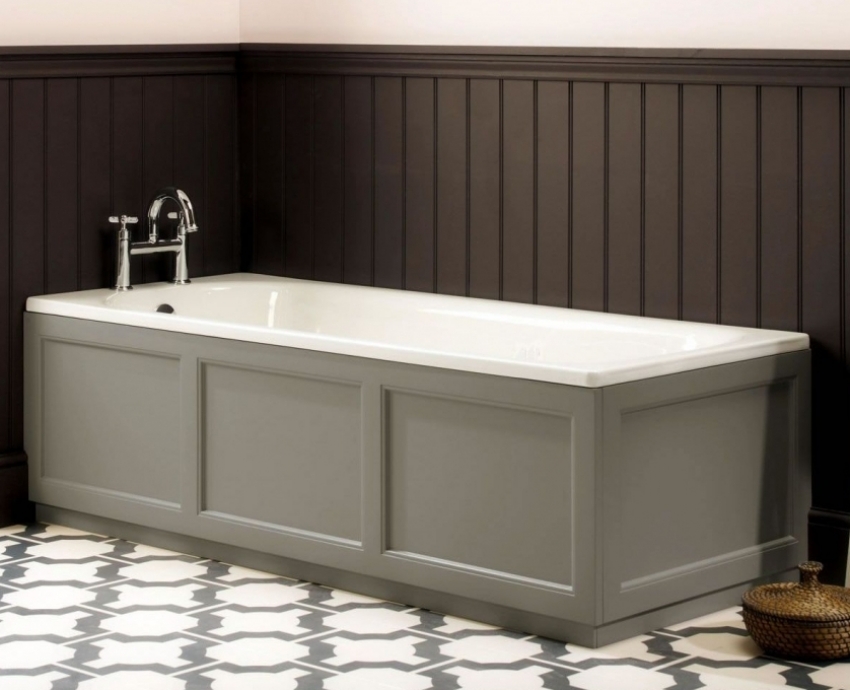
A solid screen has its advantages, the most important thing is that it can be faced with various finishing materials to your taste
However, such panels also have some disadvantages that you should pay attention to:
- in some cases, the small size of the viewing window is not enough to carry out repair work under the bathroom;
- lack of the ability to store household chemicals under the bathroom;
- in the presence of such a panel, replacing the bowl is accompanied by some difficulties, since the structure will have to be dismantled.
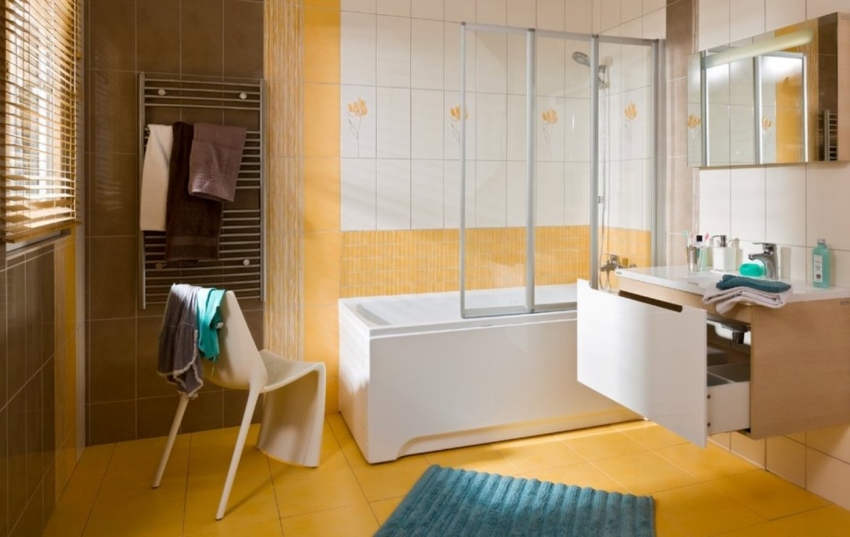
The disadvantage of a solid screen is that it does not provide for either access to water pipes, or the possibility of storing various tools and household chemicals under the bathroom
Note! To access the communications that are located under the bath bowl, it is necessary to equip an inspection hatch of sufficient size. If there is such a hatch, there are no problems with the repair of pipes, since the dismantling of the shielding is excluded.
Thus, a solid screen is an excellent solution for a bathroom interior, but its use is associated with some inconveniences.
Bath screens dimensions
Protective panels differ not only in their design, but also in size. There are both standard and non-standard screen models. Today, the minimum length of these products is 105 cm, and the maximum can reach 190 cm.
Consider the dimensions of the most common screens:
- length - 150, 170 cm;
- width - from 50 to 56 cm;
- thickness - 3 mm.
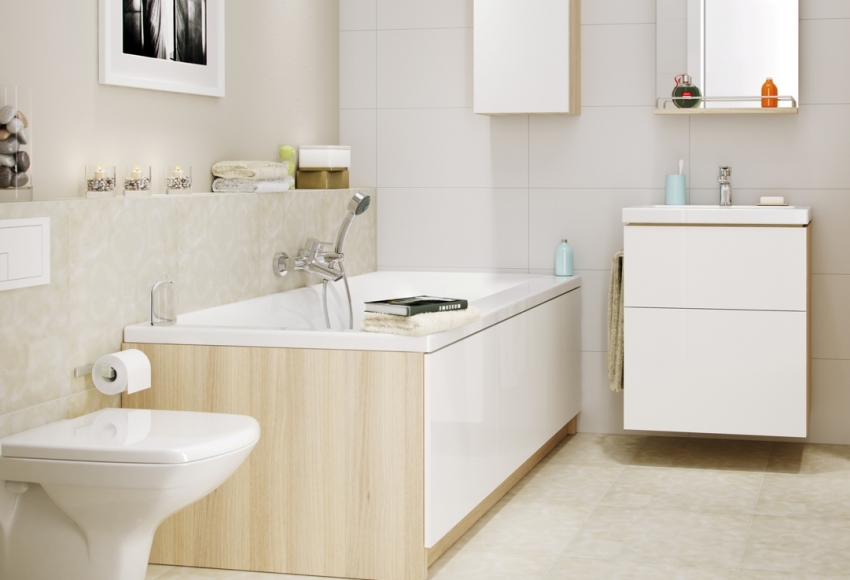
Before buying a screen, you need to take measurements of the bath from all sides, and only knowing its exact dimensions, go buy the model you like
Less common model sizes are 160, 180 and 190 cm. Shielding of non-standard bathtubs is much more difficult to perform, since it is not always possible to find a suitable product on sale. Bath screens of 150 cm are the most common and easy to install.
Solid panels are equipped with feet that are necessary for adjusting or adjusting the product. Bath screens of 170 cm are also standard and are used much more often than models with a length of 180 or 190 cm.
Screen design differences
The construction market offers many varieties of such panels for every taste. They differ in design and functionality. Many companies are engaged in the production of custom-made bath screens, which allows us to say with confidence about a large selection of these products.
Consider the types of such protective panels, depending on the design features:
- standard;
- multifunctional;
- end.
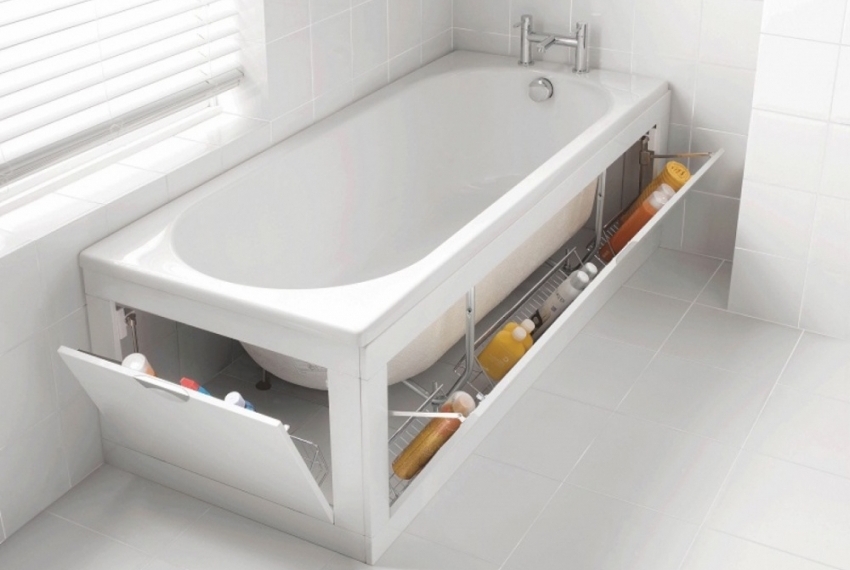
The configuration of various screen models can be determined independently, depending on your finances and technical preferences
Standard models are the most common and consist of a plastic panel for which a frame of appropriate dimensions is selected. The multifunctional version differs from the standard one in that it has the ability to adjust the size of the screen for the bath (due to the legs). End panels are used to hide only a certain part of the bathroom.
Helpful advice!Today you can find products equipped with various auxiliary elements that are necessary for convenience. Such products include panels with shelves, handles for people with reduced mobility, and screens that include a leg opening.
Photos of screens for baths can be easily found on the Internet, which greatly simplifies their selection.
Related article:
Sliding bath screen: the best solution for a small bathroom
Varieties, advantages and disadvantages of sliding screens. Selection rules. DIY assembly and installation of a sliding screen.
Features of plastic models
Plastic shielding options are the most popular today. They are distinguished by their attractive cost, as well as ease of installation and operation. The service life of such panels can be up to 10 years (subject to proper care). Plastic screens are moisture resistant and do not rot over time.
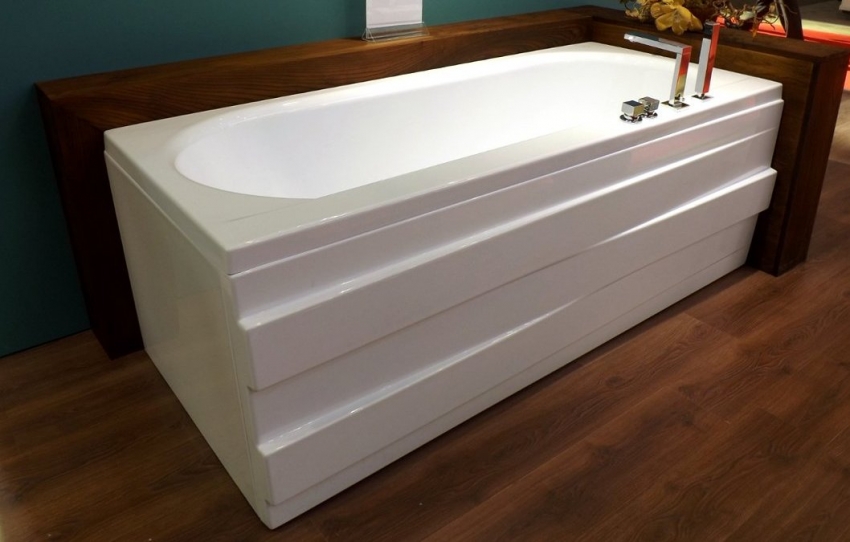
Important advantages of the plastic frame are moisture resistance, as well as the range of its colors.
The main advantage of panels made of this material is a variety of colors. This is due to the simplicity of the production of polymer products. The functionality of these screens may also differ. In specialized stores you can buy plastic screens for baths with shelves, sliding, solid, removable, folding, etc.
If you wish, you can perform the shielding yourself. This will require an inexpensive polymer lining. Such a panel does not require additional facing work, which has a positive effect on financial costs. To fix the plastic lining, it is necessary to mount a profile made of wood or metal.
The main disadvantage of plastic screens of any type is poor resistance to mechanical stress (shock). When self-installing a plastic solid screen, you need to take care of organizing the door under the bath for quick access to hidden communications. You can make a special door yourself or buy it in a store.
Acrylic Bath Screens
A popular type of cover plate that is often sold with acrylic bathtubs themselves. Such products are made of plastic material, which is subsequently processed with an acrylic layer. They all differ in individual performance. Therefore, experts do not recommend buying acrylic models separately from baths, since it is almost impossible to find a suitable option.
Acrylic panels are only suitable for installation under baths of the same material. In most cases, these panels are solid, however, other varieties can be found commercially. If it is not possible to purchase a suitable screen for a specific bathtub purchased earlier, it is recommended to buy a custom-made screen for a bathroom.
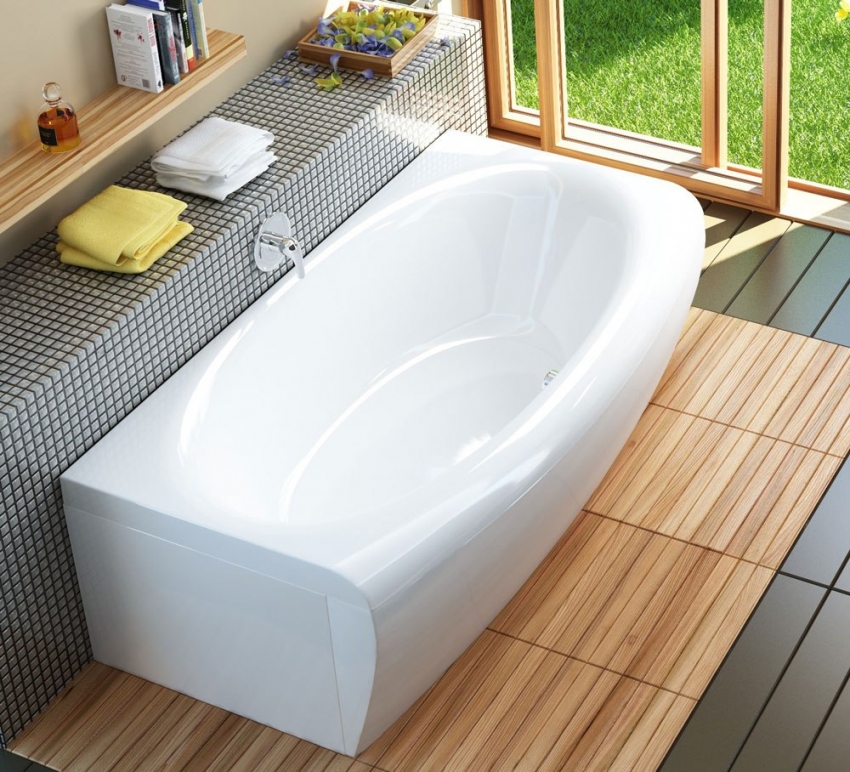
Acrylic bathtubs are often sold with screens, which are usually made of plastic panels with a similar finish.
Note! Acrylic models have the same color scheme as the bathtub, which allows the overall design to look organic.
Of the advantages, it can also be noted that such panels fit snugly against the sides of the bowl. The frame and fixing elements for fixing the panel are supplied to customers complete with the screen itself.
Screens from MDF sheets and mirrors
MDF bath screen is most often used in classic room design, as it has a woody pattern. A wide range of colors and textures allows you to choose a product that will fit any interior. MDF shielding looks stylish and expensive, which often attracts buyers. However, when buying such a screen, you need to pay attention to two important points:
- products made of this material are suitable only for standard, rectangular baths;
- MDF screens are made by pressing sawdust, so they are not resistant to moisture. In order to solve this problem, it is necessary to choose a moisture-resistant material that is equipped with a protective film.
The demand for mirror models is easy to explain.Most modern bathrooms are small in size, and the mirror surface is able to visually increase the space of the room. These panels also add a play of light. They can be mounted at different angles, as well as equipped with special lighting (for example, neon).
In any case, the mirror screen looks very impressive. However, such panels are not without drawbacks, including: fragility and difficult maintenance. Water droplets and streaks on a mirror surface are much more noticeable than on any others, so you will have to wipe them down quite often.
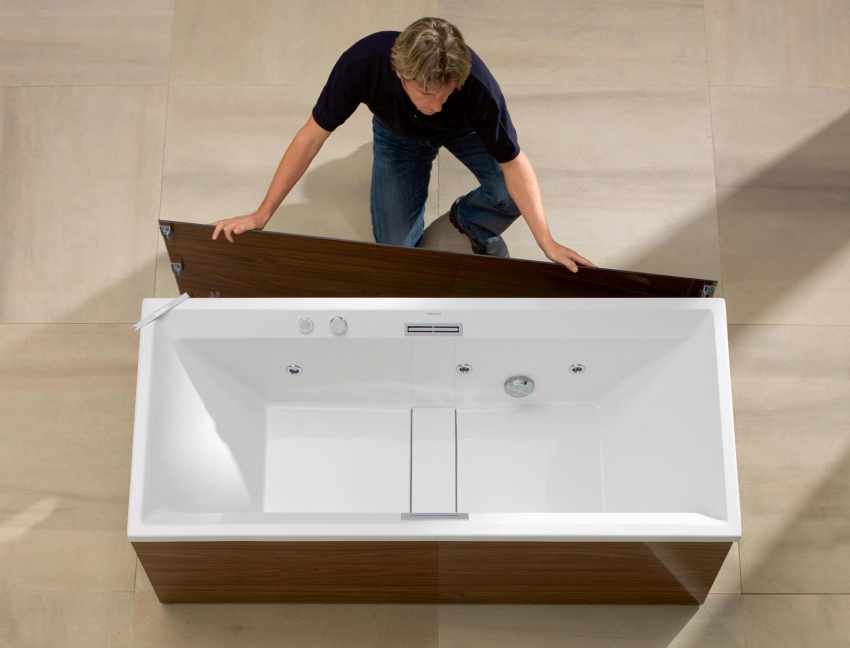
You can make an MDF screen with your own hands, which will be exactly the same as bathroom furniture
Plasterboard bath screen
The panels, which are made of plasterboard material, are affordable and inexpensive. It is quite easy to organize drywall shielding with your own hands. In most cases, after installing the plasterboard screen, it is faced with ceramic tiles.
Important!To shield the space under the bathroom, you must use a moisture-resistant type of drywall sheet.
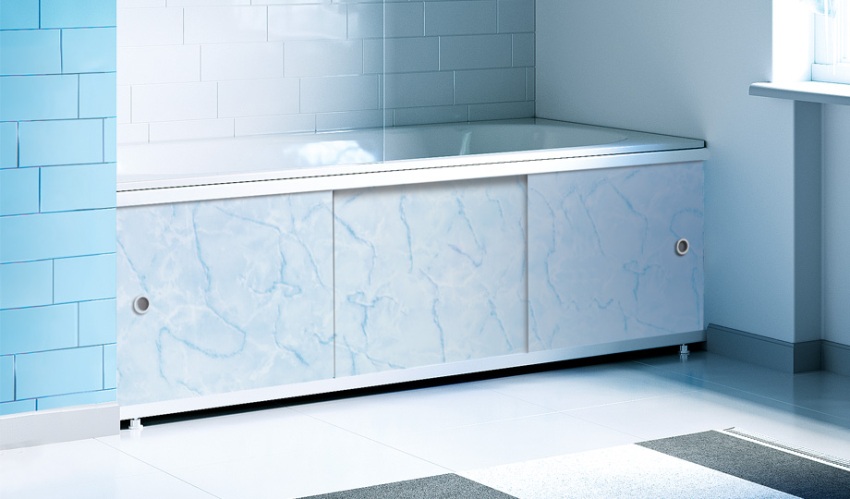
Moisture-resistant drywall can be used to make a screen, because it has many advantages and is not affected by moisture
Consider the process of installing screens for drywall baths:
- First of all, you need to assemble the frame. The material for assembling the frame is a bar with dimensions of 40x40 mm. At this stage, fixing elements and metal corners are installed.
- Further, markings are applied to the walls and floor, which is needed for orientation during the installation process.
- After applying the markings, the rails are installed along it. The slats are installed both vertically and horizontally.
- Next, a front panel is cut out of the plasterboard sheet, on which hinged hinges or latches are installed.
- The product is installed and an inspection hole is made in it.
Ceramic screens for bathrooms
Ceramic shielding allows you to organically decorate the sanitary unit. The main advantage of organizing a ceramic protective panel is that it looks as presentable as possible. Ceramic tiles are the main finishing material for arranging plasterboard screens, as well as tongue-and-groove plates. Ceramic tiles are resistant to moisture, easy to clean, and also resistant to mechanical stress.
Installing a screen under a tile bathroom is quite simple. To carry out the installation, you do not need to have special construction knowledge and skills.
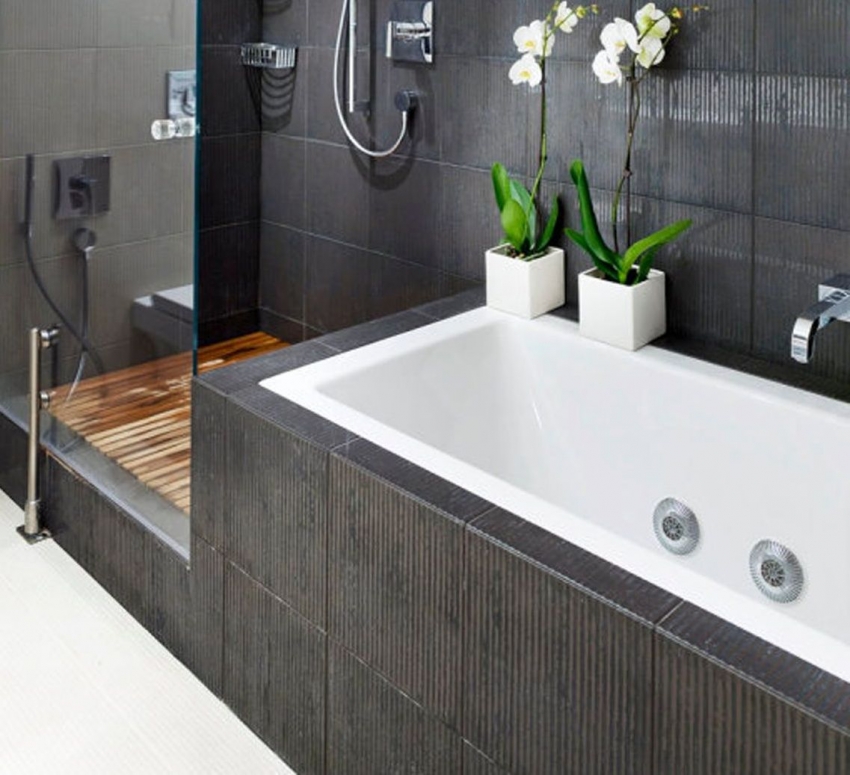
Usually, the screen is tiled with the same tiles as the entire bathroom, so it fits perfectly into the interior of the room
Consider the recommendations for laying ceramic tiles:
- first you need to take measurements (width and height of the opening under the bathroom);
- ceramic tiles are laid from the upper left corner. A very important point is that the laying should be carried out strictly horizontally;
- each individual tile element must be lubricated with tile glue;
- the alignment of the ceramic screen consisting of tiles is performed using special crosses. Such crosses are inserted into the gaps between the tiles and form the same distance for all structural elements;
- not only solid screens can be tiled with tiles.
Bath screen made of curtain fabric
There is no doubt that such a curtain is a non-standard solution. But it has several obvious advantages over rigid materials. The main advantage of the bath screen is its ease of manufacture and installation. To organize such a curtain, you will need a curtain fabric (300x60 cm), thread, a needle, as well as scissors and hot gun.
People who have a rigid bathtub panel are constantly hitting it with their feet. Bathtubs with such panels are inconvenient to wash.Using a curtain solves this problem.
Note! This non-standard solution is only suitable for rooms with good ventilation, since the curtain is not able to protect pipes from humid air.
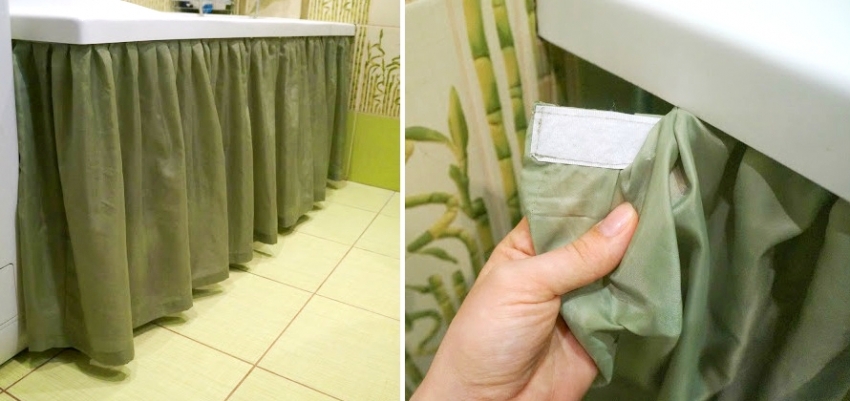
The main advantage of a curtain for a bathtub made of curtain fabric is its ease of manufacture and installation.
Screen Selection Tips
Before purchasing a bathtub cover, you should pay attention to the following points:
- before purchasing the panel, it is recommended to take measurements of the bathroom and bowl;
- the choice of product design depends on two factors: the financial capabilities of the buyer and the size of the bathroom. For example, it is not recommended to purchase flip-down models of bathroom screens, the dimensions of which are standard. For small spaces, solid models are best;
- a model with doors allows not only to protect communications, but also to organize a small warehouse under the bathroom for household chemicals and other items;
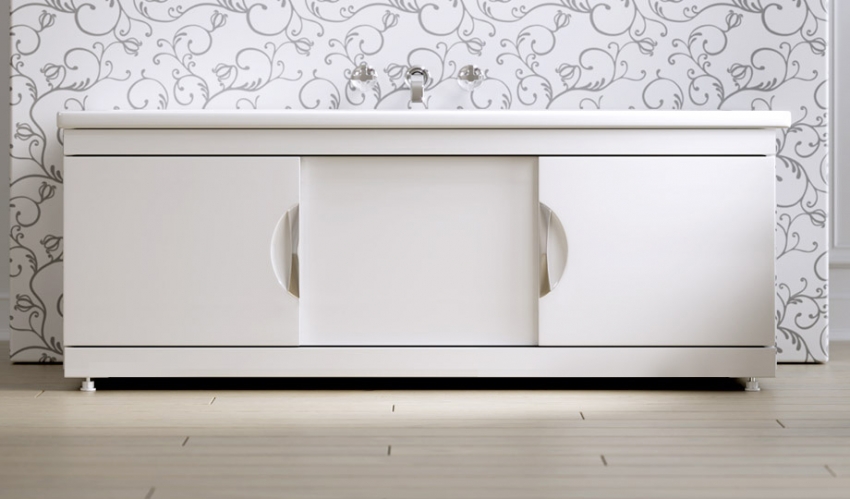
It is important to take into account when choosing a screen so that it meets all the requirements and is as functional as possible in a particular bathroom.
- it is recommended to pay attention to the material from which the panel fittings are made. It is very important that the material has good corrosion resistance;
- the panel should be freely adjustable, therefore, before purchasing the product, you need to check the legs;
- the optimal material for the panel frame is aluminum;
- bathroom screens made of MDF are suitable for rooms equipped with a good ventilation system. Otherwise, due to stagnant moisture, this material can quickly deteriorate.
The design of the panel is selected depending on the individual preferences of the apartment owners. Assembling a bath screen with your own hands will significantly save money.
- riho bathtubs
How to make a do-it-yourself bath screen from drywall and tiles
Before starting self-assembly of a solid panel, you must prepare the following tools and materials:
- drywall;
- building level;
- facing tiles;
- grout for facing tiles;
- grinder, drill, screwdriver;
- special sealing compound.
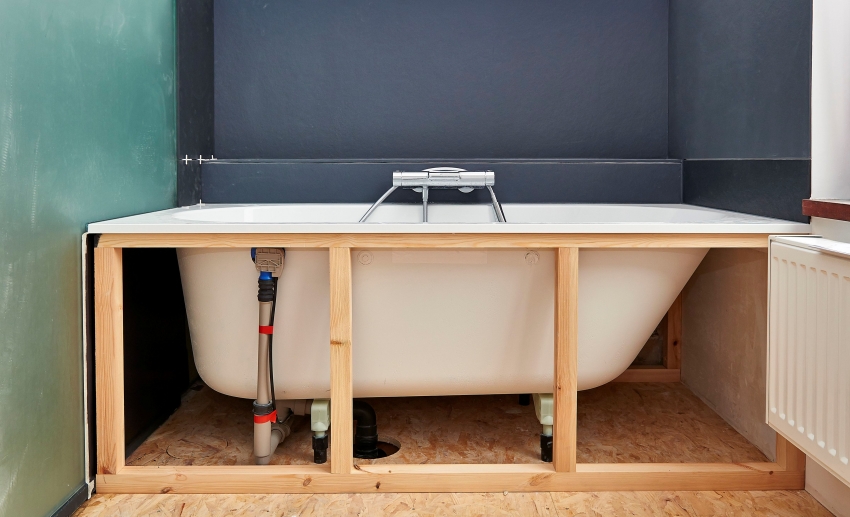
Before installing the frame, you must first take all the necessary measurements and apply the markings on the walls and floor
Assembling a drywall panel is a common exercise. This is due to the availability of material, financial benefits and ease of execution of the shield. The moisture-resistant drywall used for this purpose has good flexibility, which allows the panel to be made with an irregular shape.
How to make do-it-yourself screens under the bathroom? Consider the sequence of actions:
- First, the markup is done. The markings must be applied to the walls and floor, which will eliminate installation errors in the future.
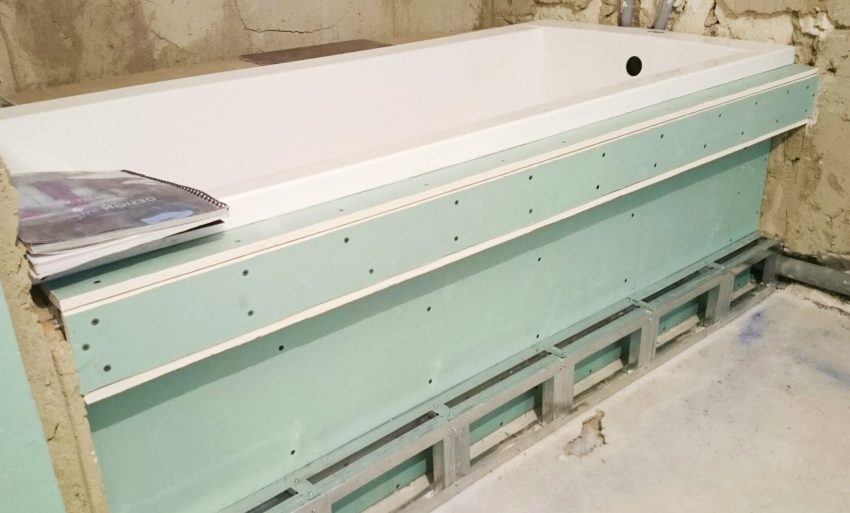
It is better to make the frame for the screen under the bath from metal profiles, since this is a damp room
- At the second stage, it is necessary to form a frame structure for the panel. The frame can be made of wooden battens or metal profiles. To assemble the frame, you need a drill and a screwdriver.
- After the frame is ready, it is necessary to sheathe it with plasterboard sheets. For this, special self-tapping screws are used for drywall.
- Further, it is necessary to fill all seams and joints in the resulting structure with a hermetic composition.
- At this stage, the front part of the plasterboard board is treated with a primer.
- At the end, the plasterboard panel is faced with ceramic tiles.
Helpful advice! Experts recommend treating the frame elements with protective compounds. This is necessary to improve the moisture-resistant qualities of the structure.
Thus, assembling a panel for a drywall bathroom with your own hands is not difficult.And the finished screen will dramatically improve the look of your bathroom. If necessary, you can buy screens for a bath in a specialized store or on the Internet.
Mounting a plastic or acrylic screen on a bath
As a rule, instructions are attached to the panel, which must be studied before installing the screen under the bath. For structures that differ only in size, the assembly process will not make much difference. The main differences in this case boil down to the fact that the legs for the shields for a high bath have an additional headroom (about 5 cm).
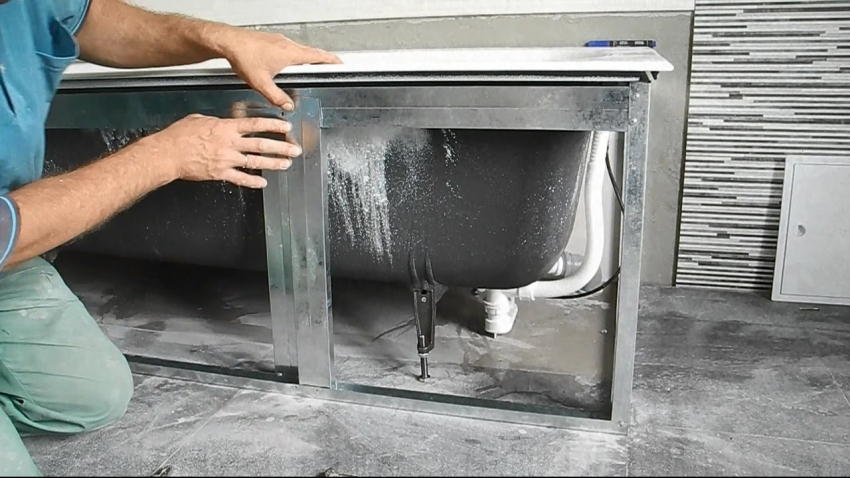
To securely fix the metal frame, the guides for the screen under the bath are twisted with self-tapping screws or with the help of special corners
Let's consider step by step how to install a screen under the bath:
- Before starting the installation of this design, it is recommended to fill the bath with water.
- It is necessary to install special handles on the outer panel of the screen, which are mounted for ease of use of the structure.
- The legs of the product go separately. They need to be inserted into the holes located on the bottom of the screen.
- Next, you need to get the panel under the bath rim.
- After that, the structure must be fixed with auxiliary components.
In some cases, the bathroom differs in that it has protruding communications or a baseboard, the presence of which makes it difficult to completely block the free space under the bathroom with a shield. How to install a screen under the bath in such a situation? It is best to measure the parameters of the protruding elements and make a corresponding hole in the screen. Then the screen will not bump into the protruding element of the plumbing unit. Of course, you can remodel the bathroom, but this more time-consuming and expensive event is not for everyone.
How to install a screen on an acrylic bathtub?
To install the screen on an acrylic bathtub, you must adhere to the following work algorithm:
- First of all, you need to carry out the markings on the side and screen. The markings must correspond to the anchor points.
- At the next stage, you need to attach the shield to the bathtub at a certain angle of 30–40 ° and bring its top between the side and the mount.
- Further, the previously marked places on the side and the shield are drilled under the screws.
- At the end, the holes that must match are fixed with self-tapping screws.
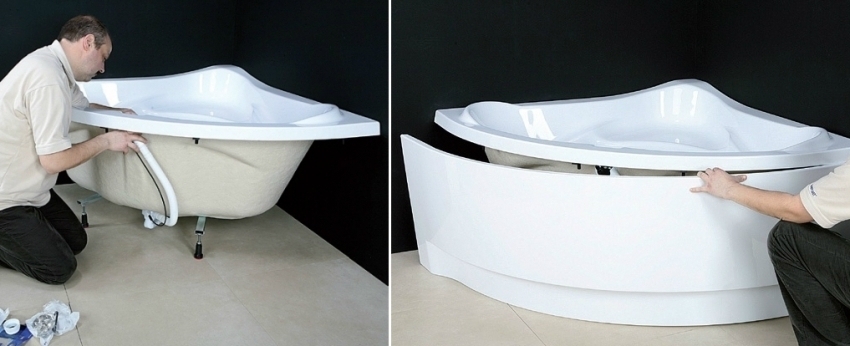
If the screen is installed under an acrylic bathtub, the fasteners can be mounted directly on its sides
Screens for acrylic bathtubs have good resistance to moisture and also have a long shelf life. Experts recommend that you carefully study the instructions before installing such a protective panel. The instructions describe all the necessary nuances of installation.
